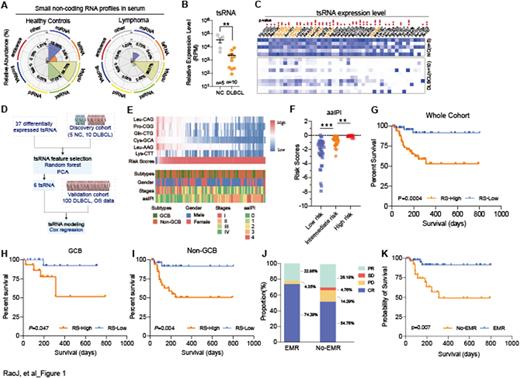Abstract
Background: Diffuse large B cell lymphoma (DLBCL) is the most common subtype of non-Hodgkin lymphoma, which features highly aggressive and heterogeneous lymphoid malignancy, and remains to identify novel predictive molecular markers an overdue challenge in the disease's clinical management.
Patients and methods: Small non-coding RNA sequencing was performed in serum of 10 DLBCL patients and 5 healthy controls, 6 feature tsRNAs were selected by employing random forest and principal component analysis, a 6-tsRNA-based classifier was established using cox proportional hazards modeling with leave-one-out (LOO) cross-validation strategy, RT-qPCR was used to measure tsRNA expression in 100 DLBCL patients and 35 healthy controls.
Results: we found that tsRNA were sensitive biomarkers in both lymphoma early detection, drug response, and prognosis. Specifically, high-risk patients stratified by using the classifier had significantly lower overall survival (Hazard ratio: 6.657, 95%CI 2.827-15.68, P=0.0006) compared with low-risk patients. Meanwhile, the 6-tsRNA-based classifier was significantly correlated with the patient's histology subtype, stage, and aaIPI scores. Dynamic classifier analysis demonstrated that patients who achieved 1.06 drops after one cycle (early molecular response [EMR]) showed better treatment response and superior prognosis. In addition, the 6-tsRNA-based signatures precisely discriminate between healthy control and lymphoma with AUC 0.882 (95%CI 0.826-0.939).
Conclusion: our risk classifier comprising the 6-tsRNA expression may make contributions to individual prognosis prediction and treatment decision-making.
Disclosures
No relevant conflicts of interest to declare.
Author notes
Asterisk with author names denotes non-ASH members.


This feature is available to Subscribers Only
Sign In or Create an Account Close Modal